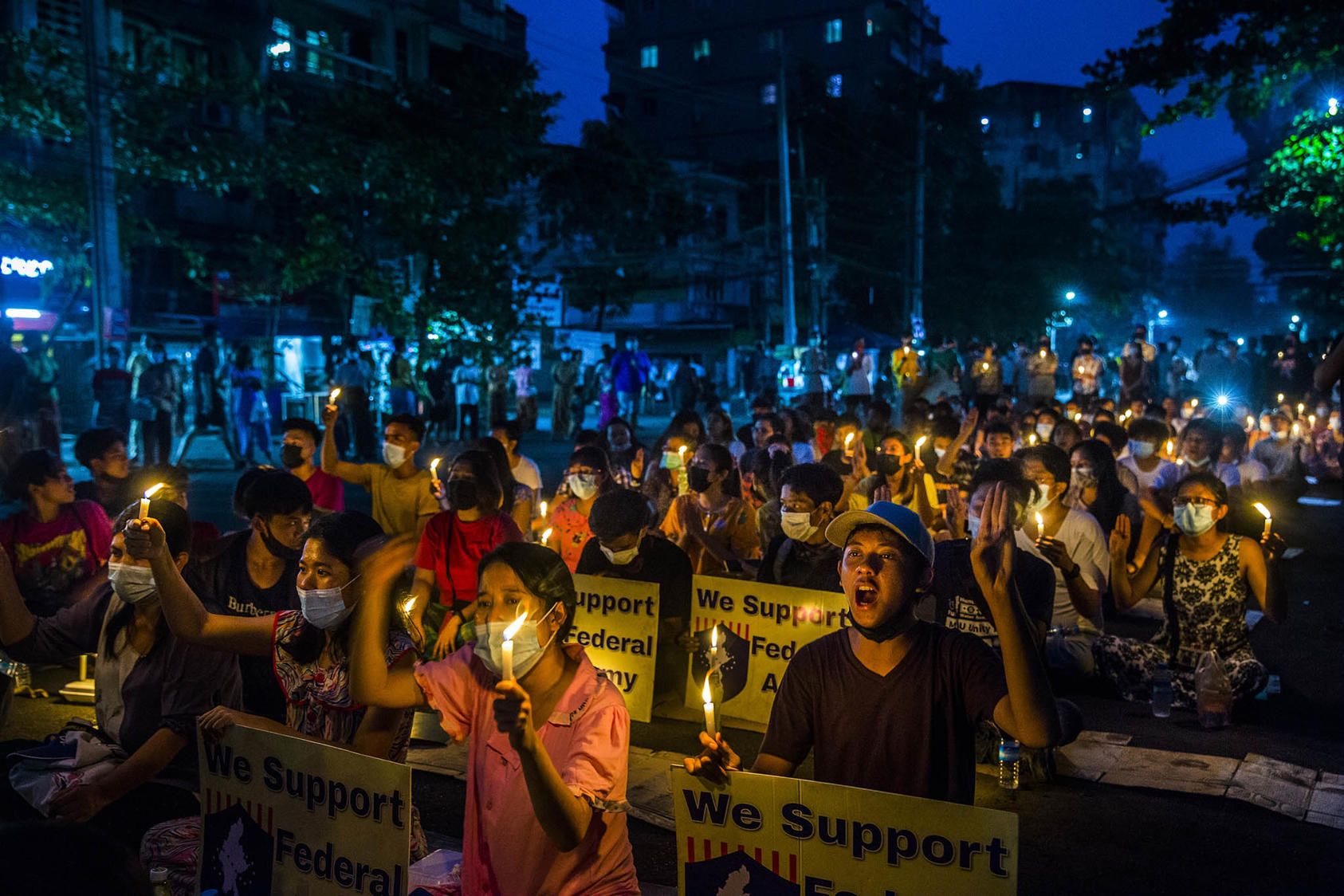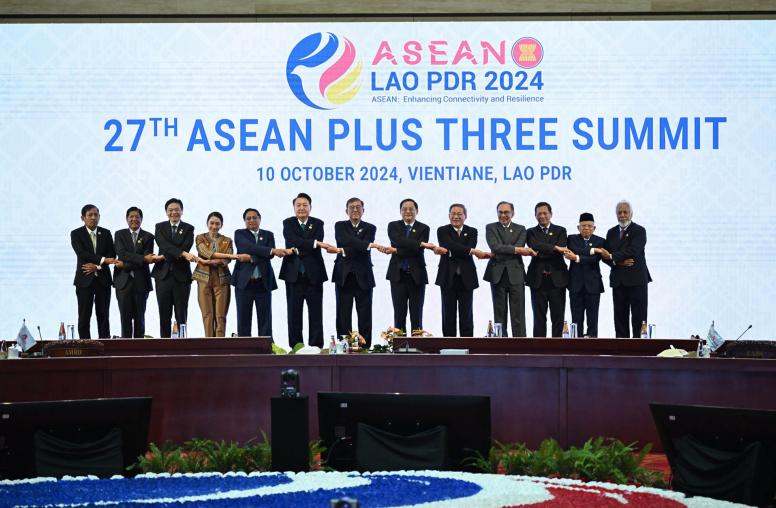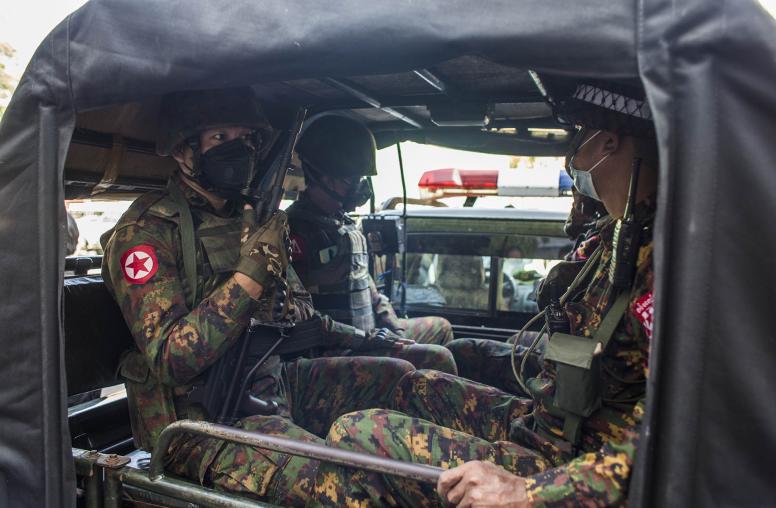For Myanmar, the Only Path to Stability Runs Through its Web of Resistance Forces
Perfect unity among the coup regime’s opponents is neither realistic nor optimal, but greater coordination and cohesion is fundamental to their success.
Even as Myanmar’s resistance forces gain ground on the battlefield, much of the international community continues to view the country’s anti-coup movement as fragmented and lacking cohesion. That perception has led some to throw up their hands and disengage from the conflict, while others are considering accepting the junta’s sham elections as a path to restoring stability. Both the premise and conclusion are wrong.

If the international community is serious about supporting the emergence of a stable Myanmar, it must abandon its naïve and myopic hope that a fake election staged by an illegal, reviled and genocidal military junta can bring about peace. Instead, it must significantly increase support for resistance dialogues that are a viable, if challenging, path to stability.
It's true that the resistance grapples with division. But on what matters most – the mission to defeat the military and remove it from government — its factions are all aligned. Furthermore, this fundamental alignment has opened the door for unprecedented cooperation, coordination and dialogue among groups that historically have been at odds. Intra-resistance dialogues have already made momentous progress – constructing the broadest and most inclusive governance organizations in Myanmar’s history (the National Unity Consultative Council and the National Unity Government); producing its most democratic and equitable political roadmap (the Federal Democratic Charter, FDC); and coordinating military activity that has reduced junta control to a small fraction of the country’s territory.
Despite such success, these dialogue platforms, especially the National Unity Consultative Council (NUCC), are widely thought to be ineffective and slow – plagued by factional politics, historical grievance and mistrust. And although the FDC includes a roadmap to stabilization, it is seen as lacking broad enough support outside of the NUCC to offer a credible pathway to stability.
While overblown, such critiques highlight the need for greater cohesion if the opposition hopes to gain international support, and attain the level of coordination needed to defeat the junta. Meeting those challenges will help steer the international community away from the coup regime’s sham elections — which are sure to incite violence and fragmentation — and toward an alternative route to stabilization.
The most promising platforms to date are those that coordinate military strategy and subnational governance. These councils focus on points of alignment such as defeating the junta and providing for besieged communities rather than on contentious political details like the name and number of subnational federal units in a future Myanmar. As trust between historically adverse communities builds through these platforms, it is sure to create space for more difficult discussions about the country’s future.
Resistance groups could then begin their next-stage conversations by backing a broad set of principles constituting a framework for the long political dialogue ahead. The international community must do more to support these efforts if it hopes to contribute to the emergence of a peaceful and stable Myanmar, especially after the NUG president this week broached for the first time conditions that could lead to talks with the military.
Progress Toward Cohesion
Soon after the February 2021 coup, ethnic minority and Bamar leaders saw potential in the national uprising that followed to strengthen trust among Myanmar’s historically divided communities. Baw Kyaw Hae, the vice chief of staff for a prominent Karen group that has fought the military since the late 1940s, wrote in an open letter that “never has there been such a great opportunity during the 70-plus years of revolution … Let us stand united to … escape the military dictatorship.”
Although protests initially focused on releasing imprisoned leaders and returning to the pre-coup arrangement, they quickly broadened to include calls for wholesale political change that would address decades of internal conflict.
Since then, various organizations and dialogue platforms have emerged in pursuit of this aim:
The National Unity Government: The NUG is primarily composed of representatives of the deposed ruling party, the National League for Democracy (NLD), and also includes Ethnic Revolutionary Organization (ERO) representatives and prominent resistance leaders. It is the most diverse governing body in Myanmar’s history, with ethnic minorities in positions of president and prime minister. But it is seen by some as closely aligned with the NLD’s political objectives. Although the NUG is just one organization, its size and diversity mean that it hosts many of the most important and contentious discussions about the future of Myanmar.
The Alliance Committee of the NUG: Given the necessity for better engagement with ethnic political forces, the NUG formed the Alliance Committee, which is primarily responsible for outreach to the EROs and expanding alliances among resistance groups. The Alliance Committee has increased its interactions with EROs, particularly non-allied groups such as the Arakan Army (AA), EROs from northern Myanmar, and other ethnic minority political forces. Its efforts have been fairly effective as evidenced by the fact that the NUG’s communication with northern EROs and the AA has become more regular. While it has received little public attention, the Alliance Committee is one of the most important platforms for the NUG to engage with the ethnic political and armed forces.
National Unity Consultative Council: The council is composed of representatives from the NUG, the deposed elected legislature, human rights and civil society organizations, the Civil Disobedience Movement, activist networks, ethnic minority political parties and EROs. The mandate of the NUCC is to produce policy and governance frameworks for an interim and post-conflict Myanmar. The NUCC is hampered by slow decision processes, uncertain legitimacy, distrust among key members, and the absence of the powerful groups, among other challenges. However, as one of the key platforms working on a political vision for the future federal democratic state, the NUCC is too important to fail.
Military Coordination Platforms: The NUG and its allied EROs formed two key military coordination platforms that unite historically divided groups around the shared goal of defeating the junta — the Central Command and Coordination Committee (C3C) and Joint Command and Coordination (J2C). The C3C includes the NUG, Kachin Independence Army, Karennni National Progressive Party, Chin National Front and the All Burma Students Democratic Front. The J2C is the joint committee between the NUG and the Karen National Liberation Army. If the NUG can improve its relations with powerful ethnic armed groups in the north and incorporate them into a military coordination platform, the balance of military power could swing decisively in favor of the resistance. It could also help deepen trust, which would enable more meaningful political dialogues.
State and Local-level Government Bodies: As resistance forces have gained ground against the junta, they have established new governance structures at the state and local level. These institutions take various forms, but in places like Karenni (Karenni State Consultative Council) and Chin States (Interim Chin Consultative Council) they have become important platform for various actors, civilian and armed, to discuss complex governance issues. The dialogues not only offer opportunity for confidence-building, but they are also experiments in decentralized, federal governance that could be a model for the future.
The Goal is Not Unity
A prominent Burmese historian, Dr. Kyaw Thet, observed that “the problems of political integration have existed and never been adequately solved in Burma.” That was in 1956, six years before the Burmese military’s first coup. Three coups and 66 years later, the same bloody internal armed conflicts continue to plague the country. These struggles, ongoing since independence in 1948, have been driven by political disintegration and inter-ethnic hostility fomented by military regimes obsessed with a twisted form of national unity that amounts to Bamar Buddhist domination.
Against this background, unity is neither realistic nor optimal. USIP-supported research in Myanmar found that “unity,” in fact, is stigmatized as implying a flattening of identity and erasure of difference.
Historically, central Bamar authorities have used calls for unity as a proxy for top-down control, and the Burmese military has justified its domination of politics with the myth that it is the unifier of a fractious nation. For ethnic minorities, national unity, therefore, means forced submission under Burmese domination.
Individuals interviewed by the researchers emphasized that the diversity of actors involved in this revolution is key to its resilience.
“It has become cliché to say you need unity to defeat the military,” one said. Instead, she and others argued, the revolution’s leaders must acknowledge that each ethnic group has its own history and values. What’s needed is not perfect unity, she said, but a just system to manage diversity – the foundational challenge of any democracy
Rather than get trapped in the stigmatized mantra of unity, anti-junta groups could leverage the trust-building arising through military and governance coordination and establish a broad framework and set of principles that will be the foundation for the long road ahead of political dialogue.
Sequencing and Support
The coup regime offers no path to stabilization. It has virtually no public support; it controls less than a quarter of Myanmar’s territory; and it has no prospect for a military victory. The resistance, by contrast, does. It is not a simple path, but it is the only feasible one. The resistance and its supporters can pursue it in three phases:
- Increase military coordination by convening under a single platform that includes members of the C3C, J2C and others involved in on-going bilateral coordination efforts. Concurrently strengthen coordination in the provision of local governance and humanitarian assistance.
- Undertake a series of bilateral dialogues to elicit deeper understanding of the core principles, values, and interests of the various resistance groups, particularly those outside of the NUCC whose perspectives are not represented in the Federal Democratic Charter.
- Building on trust bred by military cooperation and other understandings, resistance groups need to work toward agreement on principles and values foundational to a future national dialogue process. The principles outlined in Part 1 of the FDC could underpin this dialogue.
The international community must also play its part. Special envoys and diplomats should end engagement with the military regime and instead meet regularly with and publicly support these dialogues. Financial assistance should be directly channeled to these various dialogue platforms to ensure their sustainability and enable key actors, many of whom are in hiding and financially strained, to stay engaged.
U.S. Founding Father John Adams once wrote of the American Revolution, “The die is cast. The people have passed the river and cut away the bridge.” Likewise, there is no going back for the resistance in Myanmar and no path to stability beside it.
Ye Myo Hein is a visiting scholar at the U.S. Institute of Peace and a global fellow at the Wilson Center.



